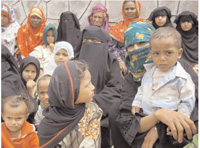
Despite the fact that fertility rate in Yemen is still one of the highest in the world, due to national efforts to promote family planning the projected population for Yemen in 2050 is now 58 million, 1.5 million less than expected in 2007. Yemen Times Photo by Amira Al-Sharif
Integrating culture into development strategy for reproductive health
By: Salma Ismail, Yemen Times, November 19, 2008
SANA’A, Nov. 19 — The United Nations Population Fund (UNFPA) last week released its annual State of the World Population Report for 2008 worldwide. The launching of the report in Yemen took place at Sana’a University and was attended by a number of representatives from the ministries of health and information, the National Population Council, as well as a number of academia and researchers.
Coinciding with the 60th anniversary of the Universal Declaration of Human Rights, the fifth report of the UNFPA, entitled Reaching Common Ground: Culture, Gender and Human Rights, focuses on cultural politics and development, and examines gender inequality and cultural differences with regards to reproductive health. It asserts the importance of cultural interaction with development strategies.
It argues for an approach that modifies development programs so that they are compatible with local cultural tradition: “Culturally sensitive programming is key to building common ground. It provides a practical and strategic response to the observation that cultural beliefs and perceptions are at the root of gender inequalities in many societies.”
The document calls for breaking the cultural barriers that hinder better communication between men and women on issues of sexuality and reproductive health and calls for the understanding of the joint responsibilities of women and men as equal partners in both their public and private lives. “Men play a key role in bringing about gender equality since, in most societies, men exercise significant power in nearly every sphere of life, ranging from personal decisions regarding the size of families to the policy and program decisions taken at all levels of government.â€
The report says that the infant mortality rate in Yemen is 58 for every 1,000 live births. The latest estimates in 2003 by the Yemeni Ministry of Health and Population were much lower at 37 for 1,000. The ministry’s report is conducted every five years and the next report is due in 2009.
Stressing the importance of education to the Yemen Times, Dr. Jamila Sale Al-Raiby, Deputy Minister of Health and Population, points to the fact that 98 percent of maternal mortality cases are illiterate mothers but stressed that there were multiple factors besides illiteracy that contribute to maternal mortality. Some of these include early marriage, poverty and poor health survices.
Al-Raiby also attributes the slight increase in the use of contraceptives and birth control methods cited in the report to the aggressive awareness campaigns by the government coupled with cheap costs.
The UNFPA report estimates maternal mortality as a result of pregnancy, delivery and related complications in Yemen to be 430 deaths per 100,000 live births. This number is a substantial improvement from last year, when maternal mortality in the country stood at 570 for 100,000 according to the report. The Ministry of Health and Population had put this number at 365 for 100,000 in 2003.
The UNFPA office in Yemen recently said there is an urgent need for 5,000 more midwives to allow the country to achieve universal access to skilled care at birth and attain Millennium Development Goal 5 “to reduce by three-quarters, between 1990 and 2015, the maternal mortality ratio”. Studies outside Yemen indicate that when there is an increase in skilled birth attendants there is a decrease in maternal mortality. It is reported that 80 percent of deliveries in Yemen take place at home.
According to UNFPA, maternal mortality in Yemen accounts for 42 percent of all deaths among women of childbearing age. UNFPA said 75 percent of maternal deaths are preventable and occur because of a lack of access to – and availability of – high-quality reproductive health services.
On a positive note, the projected population for Yemen in 2050 is now 58 million, 1.5 million less than expected in 2007. The population of Yemen now stands at 22.3 million, and is therefore expected to double by 2050. The document does mention that several of the estimates differ from official government figures.
On a global level, specific statistics from the report on gender equality show that 16 percent of parliamentarians worldwide are women, 70 percent of children who do not attend school are girls and two thirds of those who are illiterate are women.
The State of World Population 2008 report focuses links between culture and promoting human rights, especially women’s rights. Taking into consideration cultural values can assist in eliminating human rights violations, especially those against women. It presents the challenges and dilemmas of culturally sensitive strategies and suggests ways that partnerships can avoid them.
The UNFPA also released a youth supplement to the State of the World Population 2008. Titled Generation of Change: Youth People and Culture, it features stories of young women and men, their experiences and achievements in different cultures. It demonstrates how young people can be agents for positive change and how they bring about change within their own cultures, championing human rights, gender and development, often by creating their own sub-culture.